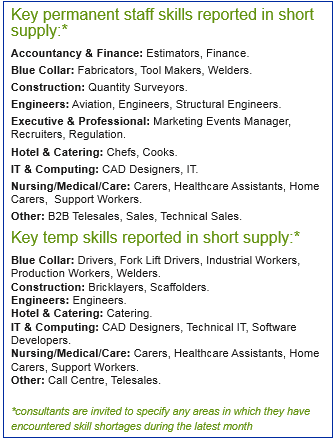Job Market Report: salaries & placements

June’s report is here – all the information you need on Salaries & Placements in the South.
We know how popular the IHS Markit Reports are – see below for their latest findings on the UK Job Market that we’ve summarised for you below.
KEY FINDINGS – UK:
- Permanent placements and temp billings continue to rise markedly
- Availability of candidates continues to decline sharply
- Starting salaries increase at quickest pace for just over a year-and-a-half
The Job Market in the South -What’s going on?
Commenting on the latest survey results, Tom Hadley, REC Director of Policy says: “With fewer people currently looking for jobs, employers are having to increase starting salaries to secure the talent they need. This is creating great opportunities for people with in-demand skills who are prepared to change jobs, but it’s also putting unsustainable pressure on many businesses.
“Existing skills shortages are being exacerbated by Brexit. Recruiters report that catering jobs are already hard to fill and across the South, excluding London, there are 101,000 EU nationals working in wholesale and retail trade jobs, hotels and restaurants.* Policies which make it more difficult to recruit and retain these people will put business growth at risk.
“Investment in training the domestic workforce is vital to the long-term health of the jobs market, but it won’t allay employers’ fears about losing access to workers from the EU. The government needs to outline a five-year roadmap for post-Brexit immigration policy to enable businesses to plan effectively, and so the UK economy can flourish.”
* Building the post-Brexit immigration system, REC (July 2017)
KEY FINDINGS – SOUTH:
- Growth in permanent placements moderates, while temp billings rise at faster pace
- South of England sees the quickest drop in candidate availability of all UK regions
- Pay pressures intensify
Permanent placements growth softens
The amount of people placed into permanent job roles in the South of England increased again in June. Although the rate of expansion moderated since May, it remained sharp overall and was stronger than that seen for the UK as a whole. According to panellists, robust demand for staff and increased business requirements drove the latest upturn in permanent placements.
Permanent labour supply continues to drop markedly
The decline in permanent candidate availability in the South of England eased slightly in June, but remained close to May’s 33-month record. Furthermore, around half of panellists noted a drop in permanent candidate numbers, compared to 10% that reported an increase. The South of England also saw the quickest drop in permanent labour supply of all five monitored UK regions for the third month in a row.
Permanent salaries
Latest data pointed to a further marked rise in starting salaries awarded to newly-placed permanent staff in the South of England. Moreover, the rate of pay inflation edged up to a three-month high, and was slightly stronger than the average for the UK. Low candidate availability and strong demand for staff were reportedly the key drivers of pay growth in June.
The South Vs rest of the UK – Regional Comparison
Staff appointments
Permanent appointments in the UK rose at a marked, but softer, rate in June. This reflected slowdowns in two out of the five regions monitored by the survey, namely the South of England and London. The strongest pace of expansion was noted in Scotland, where growth climbed to a 28-month peak. Growth of temp billings across the UK as a whole also eased in the current reporting period. Softer rates of increase were registered in the Midlands and the North, with the remaining regions all seeing accelerated expansions. Scotland was the best-performing locality on this front.

Candidate availability
June data pointed to a broad-based deterioration in permanent candidate numbers across the UK, with all regions again noting declines. The slowest pace of reduction was recorded in London and the quickest in the South of England. Temp availability again fell across the five surveyed UK regions, with rates of contraction accelerating in all cases. The steepest decrease was noted in the South of England. At the UK level, temp labour supply deteriorated to the greatest extent in one-and-a-half years.
Pay Pressures
Permanent salary inflation in the UK climbed to a 19-month peak, with stronger increases registered in four out of the five regions tracked by the survey. The steepest rise was noted in the North of England (15-month high), while the Midlands was the only area to record a softer increase in staff pay. Stronger rises in average hourly pay rates were noted in the Midlands, the South and London. Conversely, weaker increases were registered in Scotland and the North of England. At the UK level, wage inflation was at a six-month high.

Feature:
UK employment rate at joint-record high
The number of people in work in the UK rose to 31.95 million in the three months to April, according to the latest data released by the Office for National Statistics (ONS).
This highlighted an increase of 372,000 compared to a year earlier, and was the highest level of employment seen since records began in the early 1970s. Furthermore, the data shows that there are around three million more people in employment since the global financial crisis.
As a result, the employment rate held steady at a joint-record high of 74.8%. Broken down by gender, 79.5% of men aged 1664 were in employment (the highest since the three months to May 1991), while the number of women aged 16-64 in work was the joint-highest on record at 70.2%. The ONS noted that the uplift in the proportion of working women has been influenced by the ongoing changes to the State Pension age, which has reduced the number of women that retire between 60-65 years old.
Related Dovetail articles:
Sources:
Thanks as always to IHS Markit for the data.
IHS Markit offers the most up-to-date monthly picture of recruitment, employment, staff availability and employee earnings trends available in the UK.
